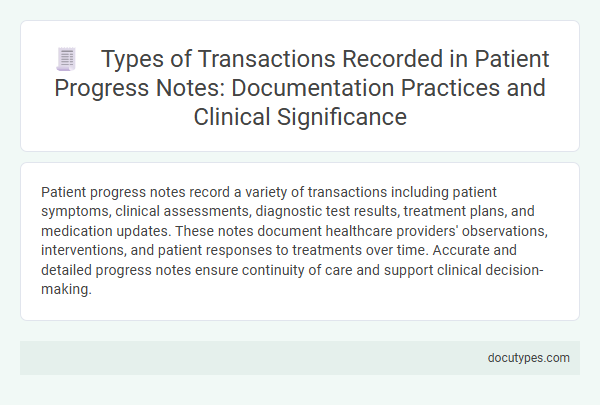Patient progress notes record a variety of transactions including patient symptoms, clinical assessments, diagnostic test results, treatment plans, and medication updates. These notes document healthcare providers' observations, interventions, and patient responses to treatments over time. Accurate and detailed progress notes ensure continuity of care and support clinical decision-making.
Introduction to Patient Progress Notes
What types of transactions are recorded in patient progress notes? Patient progress notes document all clinical transactions related to a patient's care throughout their treatment. These notes include observations, diagnostic test results, medication administrations, treatment plans, and communication with healthcare providers to ensure comprehensive and continuous patient management.
Overview of Documentation Practices in Healthcare
Patient progress notes document various types of transactions including clinical observations, patient symptoms, and treatment interventions. These notes capture ongoing assessments, medication administration, and changes in patient condition to ensure continuity of care. Accurate and timely documentation supports clinical decision-making and enhances communication among healthcare providers.
Admission and Initial Assessment Transactions
Patient progress notes document various types of transactions critical to ongoing care. Admission and initial assessment transactions mark the beginning of the clinical record for each patient.
Admission transactions include collecting demographic information, medical history, and reason for hospitalization. Initial assessment transactions involve recording vital signs, physical examination findings, and preliminary diagnostic impressions.
Clinical Observations and Monitoring Entries
Patient progress notes primarily document clinical observations and monitoring entries that track the course of a patient's health. These notes provide critical information for ongoing medical decision-making and care adjustments.
- Clinical Observations - These include detailed records of physical examinations, vital signs, and symptom descriptions observed during patient encounters.
- Monitoring Entries - Data such as blood pressure readings, heart rate, oxygen saturation levels, and other continuous assessments are regularly logged to observe patient trends.
- Symptom Progress Tracking - Changes in symptoms over time are documented to evaluate treatment effectiveness and guide your personalized care plan.
Medication Administration and Management Documentation
Patient progress notes include detailed records of medication administration and management. These notes document the types, dosages, and times medications are given to ensure accurate treatment tracking.
Your healthcare provider records each instance of medication administration to monitor patient response and detect any adverse reactions promptly. Documentation also includes adjustments to medication plans based on progress or side effects. This enables effective communication among the medical team and supports continuity of care.
Diagnostic and Therapeutic Procedure Records
Patient progress notes document various transactions related to diagnostic and therapeutic procedures performed during care. These records provide detailed information on tests ordered, imaging studies, and interventions administered.
Diagnostic procedure records capture data such as laboratory results, radiology reports, and clinical examination findings. Therapeutic procedure records include treatments like medication administration, physical therapy sessions, and surgical interventions, ensuring continuity and quality of care.
Patient Education and Counseling Notes
| Transaction Type | Description | Key Elements Recorded |
|---|---|---|
| Patient Education | Documentation of information provided to the patient regarding their condition, treatment options, medication instructions, lifestyle modifications, and preventive health measures. |
|
| Counseling Notes | Records of psychological or behavioral counseling provided to support patient well-being and promote health behavior changes. |
|
| Instruction Reinforcement | Notes on follow-up education or clarification sessions, ensuring patient comprehension and adherence to care plans. |
|
| Consent and Decision-Making Support | Documentation related to educating patients about treatment risks, benefits, and alternatives to support informed consent. |
|
Interdisciplinary Communication Entries
Patient progress notes document various types of transactions, including clinical observations, treatment updates, and medication changes. Interdisciplinary communication entries play a crucial role by capturing collaborative discussions among healthcare professionals from different specialties. These entries ensure Your care team maintains accurate, up-to-date information essential for coordinated patient management.
Discharge Planning and Follow-Up Documentation
Patient progress notes document essential transactions related to discharge planning and follow-up care. They ensure continuity and quality of care after hospital stays or medical visits.
- Discharge Instructions - Clear, detailed guidance on medications, activity restrictions, and symptom monitoring is recorded to facilitate safe recovery.
- Follow-Up Appointments - Scheduled dates and specialist referrals are documented to maintain ongoing medical supervision.
- Patient Education - Information provided to you about lifestyle changes and treatment adherence is noted to enhance health outcomes.
What Types of Transactions Are Recorded in Patient Progress Notes? Infographic

